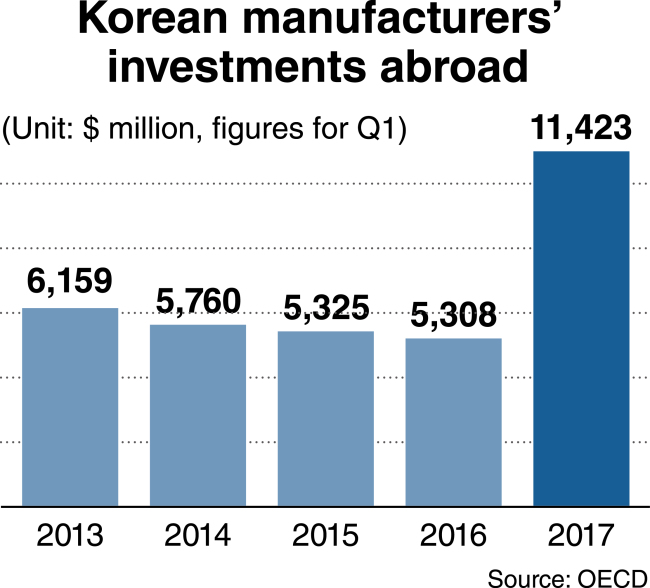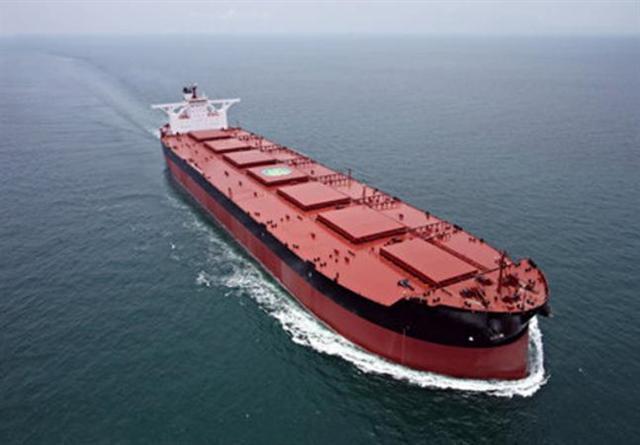South Korean manufacturing companies’ investments abroad have been increasing at a rapid pace in contrast to sluggish corporate activity at home.
Overseas investments by local manufacturers in the first quarter of this year jumped 115.2 percent from a year earlier to $11.4 billion, according to recent data from the Organization for Economic Cooperation and Development.
The increase rate exceeded 75 percent for Germany, 56.2 percent for Japan and 41.3 percent for the US, as well as the OECD average at a mere 0.6 percent. China and France saw overseas investments by their manufacturing companies shrink 65.1 percent and 225 percent on-year, respectively, during the cited period.

Local firms’ overall investments abroad amounted to a record annual high of $49.2 billion last year, according to figures from the Export-Import Bank of Korea.
Officials at the Ministry of Trade, Industry and Energy are surprised at the steep rise in Korean manufacturers’ overseas investments, which they say were supposed to increase at a decelerating pace in tandem with the sophistication of industrial structure.
This trend seems to reflect unfavorable business conditions in the country.
The atmosphere surrounding local firms has been exacerbated by measures pushed by President Moon Jae-in’s government, which are set to result in increasing burdens on companies.
Since Moon took office in May, corporate concerns have deepened over a steep minimum wage hike, pressure to turn temporary jobs into permanent ones and planned corporate tax increases.
His administration has backpedaled on labor reforms and has yet to put forward concrete plans for sweeping deregulation.
This deteriorating business environment has led many Korean manufacturers operating in China to consider moving production to Southeast Asian countries rather than back home amid Beijing’s economic reprisals against Seoul’s hosting of an advanced US missile shield.
“The environment for corporate investment should be improved drastically beyond offering some incentives, if the country could see more companies return home and less firms move abroad,” said an official at the Federation of Small and Medium-sized Enterprises, requesting anonymity.
According to data from the Trade Ministry, only five of 1,299 Korean manufacturers currently running factories abroad are considering moving production back home.
In 2013, a law was enacted to expand support for companies returning home. Since then, 43 firms have transferred overseas factories to the country.
A survey conducted by a local research institute earlier this year showed half of companies that have returned home were dissatisfied with support given to them, with less than 24 percent expressing satisfaction.
The sharp rise in overseas investments by local firms comes as they remain reluctant to increase overall capital.
Korean firms issued new shares and bonds worth 10.8 trillion won ($9.5 billion) in August, down 24 percent from a month earlier, according to figures from the Financial Supervisory Service.
Outstanding bank loans to local companies stood at 792 trillion won in the second quarter of 2017, up 3 percent from a year earlier, the slowest increase in seven years, showed data released by the Bank of Korea last week.
Large companies’ borrowings from banks, in particular, decreased by more than 10 trillion won over the preceding two years to 163 trillion won in the April-June period of the year.
 |
(Herald DB) |
Experts say this weakened appetite for capital indicates companies remain passive toward increasing investment amid growing anti-business sentiment coupled with prolonged economic sluggishness.
New foreign direct investments pledged to Korea in the first three quarters of the year declined 9.7 percent from a year earlier to $13.59 billion, according to recent data from the Trade ministry.
The country saw FDI commitments from its three major trading partners -- China, the US and the EU -- shrink over the cited period by 63.4 percent, 5.5 percent and 40.7 percent, respectively.
Ministry officials cite mounting geopolitical risks on the Korean Peninsula, the spread of protectionist practices across the globe and the prospect of additional US interest rate hikes as reasons for the decrease in pledged FDIs.
But experts note improving domestic business conditions through more aggressive regulatory and labor reforms are also essential to draw more foreign investment here.
In an inaugural meeting of a presidential commission on the “fourth industrial revolution” last week, Moon pledged drastic deregulation such as the introduction of a “regulatory sandbox” in new industries as part of efforts to promote innovation-driven growth.
He has recently emphasized the need to push for innovation-led growth to supplement his initial drive for income-led growth and fair economy.
A day before the meeting, Moon asked his senior aides to strive to push up the country’s economic growth rate above 3 percent this year, in a departure from his previous position not to stick to numerical targets.
Economists say regulatory red tape should be slashed across the board, not limited to new industries.
They are also disappointed that the Moon administration has shown no will to make the labor market less rigid to induce more Korean companies to return home and attract more foreign investors.
It has repealed measures introduced by the previous administration under President Park Geun-hye to make layoffs and changes to working conditions easier.
Some economists say there are fundamental contradictions between income-led growth and innovation-driven growth as envisioned by Moon and his policymakers.
By Kim Kyung-ho
(
khkim@heraldcorp.com)








![[Today’s K-pop] Blackpink’s Jennie, Lisa invited to Coachella as solo acts](http://res.heraldm.com/phpwas/restmb_idxmake.php?idx=644&simg=/content/image/2024/11/21/20241121050099_0.jpg)
